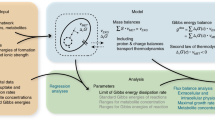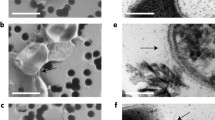Summary
Data regarding the degree of energy conservation as determined by the\(Y_{O_2 }^{\max } \) and the highest rates of metabolite production reported for various micro-organisms have been collated and analysed. The results have indicated that the highest rates of metabolite production occur in micro-organisms possessing low efficiencies of energy conservation. Moreover, in the case of exopolysaccharide production the oxidation state of the polymer is inversely related to the\(Y_{O_2 }^{\max } \) value of the producing organism. In general, the rate of ATP turnover associated with exopolysaccharide production or the potential rate associated with over-production of other metabolites is inversely related to the\(Y_{O_2 }^{\max } \) value of the producing organism. Analysis of current production rates for a range of metabolites suggests that there is scope for major improvements of existing processes by careful selection of appropriate micro-organisms.
Similar content being viewed by others
References
Aiking, H., A. Sterkenbury and D.W. Tempest 1977. Influence of specific growth limitation and dilution rate on the phosphorylation efficiency and cytochrome content of mitochondria ofCandida utilis NCYC 321. Arch. Microbiol. 113: 65–72.
Anthony, C. 1982. The Biochemistry of Methylotrophs. Academic Press, London.
Betlach, M.R., M.A. Capage, D.H. Doherty, R.A. Hassler, N.M. Henderson, R.W. Vanderslice, J.D. Marrelli and M.B. Ward, 1987. Genetically engineered polymers: manipulation of xanthan biosynthesis. In: Industrial Polysaccharides. Progress in Biotechnology, Vol. 3 (Yalpani, M., ed.), pp. 35–50, Elsevier, Amsterdam.
Cadmus, M.C., H. Gasdorf, A.A. Lagoda, R.F. Anderson and R.W. Jackson. 1963. New bacterial polysaccharide fromArthrobacter. Appl. Microbiol. 11: 488–492.
Cadmus, M.C., A.A. Lagoda and R.F. Anderson. 1962. Production of a new polysaccharide withCryptococcus laurentii varflavescens. Appl. Microbiol. 10: 152–156.
Carter, B.L.A., A.T. Bull, S.J. Pirt and B.I. Rowley. 1971: Relationship between energy substrate utilisation and specific growth rate inAspergillus nidulans. J. Bacteriol. 108: 309–313.
Cooper, D.G. and D.A. Paddock. 1984. Production of biosurfactant fromTorulopsis bombicola. Appl. Environ. Microbiol. 47: 173–176.
Cripps, R.E., R.N. Ruffell and A.J. Sturman. 1984. Fluid displacement with heteropolysaccharide solutions, and microbial production of heteropolysaccharide. European Patent Specification 0040445.
Davis, E.N., R.A. Rhodes and R.H. Shulke. 1965. Fermentative production of exocellular glucans by fleshy fungi. Appl. Microbiol. 13: 267–271.
Deavin, L., T.R. Jarman, C.J. Lawson, R.C. Righelato and S. Slocombe. 1977. The production of alginic acid byAzotobacter vinelandii in batch and continuous culture. In: Extracellular Microbial Polysaccharides (Sandford, P.A. and A. Laskin, eds.), pp. 14–26, American Chemical Society, Washington, DC.
Demain, A.L. 1968. Regulatory mechanisms and the industrial production of microbial metabolites. Lloydia 31: 395–418.
Demain, A.L. 1971. Overproduction of microbial metabolites and enzymes due to alteration of regulation. Adv. Biochem. Eng. 1: 113–142.
Dostalek, M. and N. Molin. 1975. Studies of biomass production or methanol oxidising bacteria. In Single Cell Protein, Vol. 11 (Tannebaum, S.R. and D.I.C. Wang, eds.), pp. 385–401, MIT Press, Cambridge, MA.
Drozd, J.W. 1978. Respiration and energy conservation inAzotobacter vinelandii. FEMS Microbiol. Lett. 3: 47–49.
Ellwood, D.C., I. Davidson, R.C. Righelato and C.E. Smith. 1978. Process for the production of Xanthan gum. United Kingdom Patent Application 2 008 138 A.
Eveleigh, D.E. 1973. Microbial monosaccharides and polysaccharides. In: Handbook of Microbiology (Laskin, A.I. and H.A. Lechevalier, eds.), pp. 89–96, CRC Press, Cleveland.
Farrand, S.G., C.W. Jones, J.D. Linton and R.J. Stephenson. 1983. The effect of temperature and pH on the growth efficiency of the thermoacidophilic bacteriumBacillus acidocaldarius in continuous culture. Arch. Microbiol. 135: 276–283.
Frankena, J., H.W. van Verseveld and A.H. Stouthamer. 1985. A continuous culture study of the bioenergetic aspects of growth and production of exocellular protease inBacillus licheniformis. Appl. Microbiol. Biotechnol. 22: 169–171.
Guerra-Santos, L., O. Kappeli and A. Fiechter. 1984.Pseudomonas aeruginosa biosurfactant production in continuous culture with glucose as carbon source. Appl. Environ. Microbiol. 48: 301–305.
Hacking, A.J., I.W.F. Taylor, T.R. Jarman and J.R.W. Govan. 1983. Alginate biosynthesis byPseudomonas mendocina. J. Gen. Microbiol. 129: 3473–3480.
Hermandez, E. and M.J. Johnson. 1967. Energy supply and cell yield in aerobically grown microorganism. J. Bacteriol. 94: 996–1001.
Heuting, S. and D.W. Tempest. 1977. Influence of acetate on the growth ofCandida utilis in continuous culture. Arch. Microbiol. 115: 73–78.
Jarman, T.R. and G.W. Pace. 1984. Energy requirements for microbial exopolysaccharide synthesis. Arch. Microbiol. 137: 231–235.
Jeans, A. 1964. Extracellular microbial polysaccharides: new hydrocolloids having both fundamental and practical properties. In: Water-Soluble Polymers, Plenum Press, New York.
Jones, C.W. 1977. Aerobic respiratory systems in bacteria. In: Microbial Energetics: Society for General Microbiology Symposium No. 27. (Haddock, B.A. and W.A. Hamilton, eds.), pp. 23–60, Cambridge University Press, London.
Kang, K.S., G.T. Veeder and D.D. Richey. 1981. Polysaccharide and bacterial fermentation process for its preparation. United States Patent 4, 286, 059.
Reference deleted.
Kristiansen, B. and R. Charley. 1981. Continuous process for production of citric acid. In Advances in Biotechnology I: Proceedings of the 6th International Fermentation Symposium (Moo-Young, M., ed.), pp. 221–227, Pergamon Press, Toronto.
Kristiansen, B. and C.G. Sinclair. 1979. Production of citric acid in continuous culture. Biotechnol. Bioeng. 21: 297–315.
Kula, M.R., Y. Aharonowitz, J.D. Bulock, A.M. Chakrabarty, D.A. Hopwood, B. Mathiasson, J.G. Morris, O.M. Neijssel and H. Satim. 1987. Microbiology and Industrial Products. Group Report in Biotechnology: Potentials and Limitations (Dahlem Konferenzen 1986) (Silver, S., ed.), pp. 71–81, Springer-Verlag, Berlin.
Linton, J.D., R.M. Austin and D.E. Haugh. 1984. The kinetics and physiology of stipitatic acid and gluconate production by carbon sufficient cultures ofPenicillium stipitatum growing in continuous culture. Biotechnol. Bioeng. 24: 1455–1464.
Linton, J.D., M. Evans, D.S. Jones and D.N. Gouldney. 1987. Exocellular succinoglucan production byAgrobacterium radiobacter NCIB 11883. J. Gen. Microbiol. 133: 2961–2969.
Linton, J.D., D.N. Gouldney and S. Woodard. 1988. The efficiency and stability of extracellular polysaccharide production from different carbon sources byErwinia herbicola. J. Gen. Microbiol. 134: 1913–1921.
Linton, J.D., J. Griffiths and M. Gregory. 1981. The effect of mixtures of glucose and formate on the yield and respiration of a chemostat culture ofBeneckea natriegens. Arch. Microbiol. 129: 119–122.
Linton, J.D., D.S. Jones and S. Woodard. 1987. Factors that control the rate of exopolysaccharide production inAgrobacterium radiobacter NCIB 11883. J. Gen. Microbiol. 133: 2979–2987.
Reference deleted.
Linton, J.D., P.D. Watts, R.M. Austin, D.E. Haugh and H.G.D. Niekus. 1986. The energetics and kinetics of extracellular polysaccharide production from methanol by microorganisms possessing different pathways of C1 assimilation. J. Gen. Microbiol. 132: 779–788.
Mason, H.R.S. and R. Righelato. 1976. Energetics of fungal growth: the effect of growth-limiting substrate on respiration ofPenicillium chrysogenum. J. Appl. Chem. Biotechnol. 26: 145–152.
Miall, L.M. 1972. Stimulatory effect of organic acids in citric acid fermentation. British Patent Specification 1293786.
Mian, F.A., T.R. Jarman and R.C. Righelato. 1978. Biosynthesis of exopolysaccharide byPseudomonas aeruginosa. J. Bacteriol 134: 418–422.
Minakami, H., E. Entani, K. Tayama, S. Fujiyama and H. Masai. 1984. Isolation and characterisation of a new polysaccharide producingAcetobacter sp. Agric. Biol. Chem. 48: 2405–2414.
Nagai, S. and S. Aiba. 1972. Reassessment of maintenance energy and uncoupling in the growth ofAzotobacter vinelandii. J. Gen. Microbiol. 73: 531–538.
Neijssel, O.M. 1977. The effect of 2,4-dinitrophenol on the growth ofKlebsiella aerogenes NCTC 418 in aerobic chemostat culture. FEMS Lett 1: 47–50.
Olijve, W. and J.J. Kok. 1979. Analysis of growth ofGluconobacter oxydans in chemostat culture. Arch. Microbiol. 121: 291–297.
Phillips, K.R. and H.G. Lawford. 1983. Theoretical maximum and observed product yield associated with curdlan production byAlcaligenes faecalis. Can. J. Microbiol. 29: 1270–1276.
Powell, K.A., B.A. Collinson and K.R. Richardson. 1980. Microbiological process for the production of poly(beta-hydroxybutyric acid) and micro-organisms for use therein. European Patent Application 001 5669.
Railton, K., D. Farago, C.R. MacKenzie, G.R. Lawford, J. Pik, H.G. Lawford and M. Moo-Young. 1981. Gel-forming exopolysaccharide production byAlcaligenes faecalis grown in nitrogen-limited continuous culture. In: Advances in Biotechnology: Proceedings of the 6th International Fermentation Symposium (Robinson, C. and C. Vezina, eds.), pp. 243–248, Pergamon Press, Toronto.
Ratledge, C. 1978. Lipids and fatty acids. In: Economic Microbiology, Vol. 2 (Rose, A.H., ed.), pp. 263–302, Academic Press, London.
Reference deleted.
Rye, A.J., J.W. Drozd, C.W. Jones and J.D. Linton. 1988. Growth energetics ofXanthomonas campestris in continuous culture. J. Gen. Microbiol. 134: 1055–1061.
Sardinas, J.L. and G. Ferry. 1973. Fermentation process for the production of citric acid. United States Patent Office 3, 708, 399.
Schlegel, H.G. and R.M. Lafferty. 1971. Novel energy and carbon sources. Production of biomass from hydrogen and carbon dioxide. Adv. Biochem. Eng. 1: 143–168.
Stouthamer, A.H. 1977. Energetic aspects of the growth of microorganism. In: Microbial Energetics: Society for General Microbiology, Symposium No. 27 (Haddock, B.A. and W.A. Hamilton, eds.), pp. 285–315, Cambridge University Press, Cambridge.
Stouthamer, A.H. 1979. The search for correlation between theoretical and experimental growth yields. In: International Reviews of Biochemistry. Microbial Biochemistry, Vol. 21 (Quayle, J.R., ed.), pp. 1–47, University Park Press, Baltimore, MD.
Stouthamer, A.H. and H.W. van Verseveld. 1985. In: Comprehensive Biotechnology, Vol. 1 (Moo-Young, M., ed.), pp. 215–238, Pergamon Press, Oxford.
Sutherland, I.W. 1982. Biosynthesis of microbial exopolysaccharides. Adv. Microb. Physiol. 23: 80–150.
Takayama, T., F. Endo, T. Nozawa, Y. Masuda, M. Mori and T. Kanayama. 1980. Process for producing a polysaccharide usingPseudomonas polysaccharogenes M-30. United States Patent 4, 230, 800.
Tanahill, A.L. and R.K. Finn. 1978. Improved process for the production of polysaccharide by fermentation of aqueous methanol. British Patent Specification 1509 684.
Tanaka, K., T. Iwasaki and S. Kinoshita. 1960. Studies onl-glutamic acid fermentation. Part 5. Biotin andl-glutamic acid accumulation by bacteria. J. Agric. Chem. Soc. (Japan) 34: 593–600.
Tanaka, K., K. Machida-Shi and K. Yamaguchi. 1969. Process for producingl-glutamic acid and alpha-ketoglutaric acid. United States Patent Office 3, 450, 599.
Vandersilce, R.W. 1987. A polysaccharide polymer made byXanthomonas. European Patent Application, Publication No. 0211288.
Weenk, G., W. Olijve and W. Harder. 1984. Ketogluconate formation byGluconobacter species. Appl. Microbiol. Biotechnol. 20: 400–405.
Williams, A.G. and J.W.T. Wimpenny. 1978. Exopolysaccharide production byPseudomonas NCIB 11264 grown in continuous culture. J. Gen. Microbiol. 104: 47–57.
Author information
Authors and Affiliations
Rights and permissions
About this article
Cite this article
Linton, J.D., Rye, A.J. The relationship between the energetic efficiency in different micro-organisms and the rate and type of metabolite overproduced. Journal of Industrial Microbiology 4, 85–96 (1989). https://doi.org/10.1007/BF01569792
Received:
Revised:
Accepted:
Issue Date:
DOI: https://doi.org/10.1007/BF01569792




